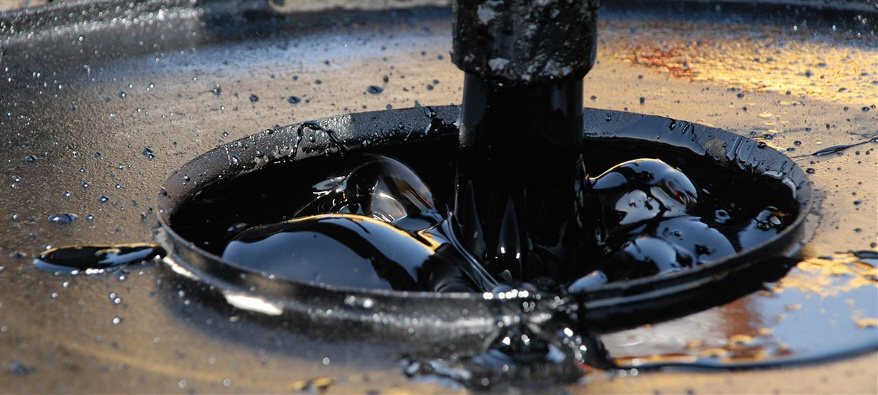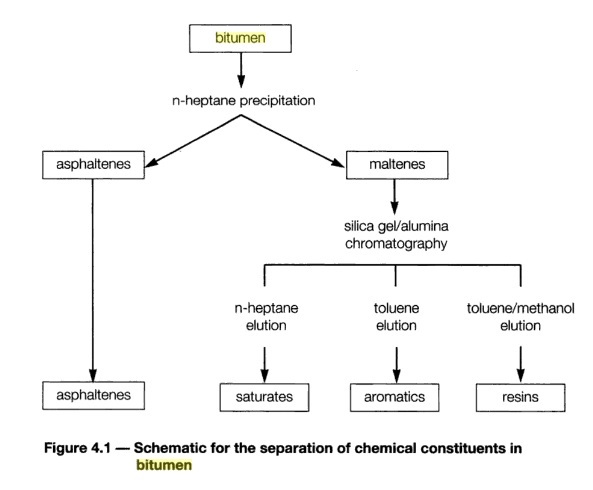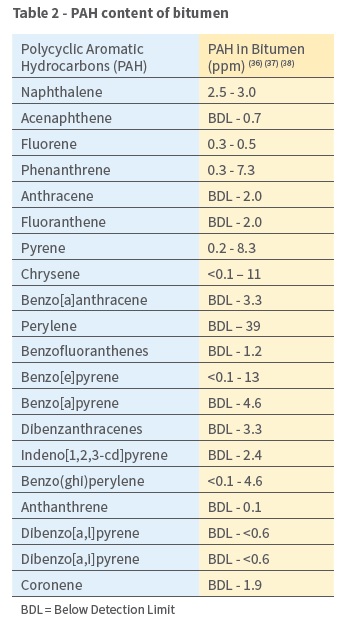
Bitumen components

Bitumen components
The bitumen components are classified into four classes of compounds:
• saturates, saturated hydrocarbons, the % saturates correlates with a softening point of the material
• Naphthenic aromatics, consisting of partially hydrogenated polycyclic aromatic compounds.
• Polar aromatics, consisting of high molecular weight phenols and carboxylic acids
• Asphaltenes, consisting of high molecular weight phenols and heterocyclic compounds
The naphthenic aromatics and polar aromatics are typically the majority components. Additionally, most natural bitumen contains organosulfur compounds, resulting in an overall sulfur content of up to 4%. Nickel and vanadium are found in the < 10 ppm level, as is typical of some petroleum.
The substance is soluble in carbon disulfide. It is commonly modeled as a colloid, with asphaltenes as the dispersed phase and maltenes as the continuous phase. and “it is almost impossible to separate and identify all the different molecules of asphalt because the number of molecules with different chemical structure is extremely large”.
Physical properties and chemical composition of bitumen
The manufacturing processes for bitumen that are described in section 3 involve the removal of lighter components to leave behind relatively high molecular weight, low volatility compounds. The resulting products all are generally solid or semi-solid materials at ambient temperature and they soften as the temperature increases.
The vapor pressure of in-situ bitumen is below the limit of detection for normal instrumentation. Bitumen is normally heated to >140°C (284°F) to become liquid to facilitate transportation and handling. Some of the performance-related physical properties are regulated by national or international specifications, while other properties, like specific gravity or vapor pressure, result from the manufacturing processes used to meet the performance specification.
Physical properties
Bitumen is thermoplastic solids or semi-solids at ambient temperature, i.e. they soften as the temperature increases and harden as the temperature decreases. At elevated temperature they behave as Newtonian liquids, the viscosity reducing with increasing temperature. This is the reason that bitumen must be heated for handling and application in their intended use. Bitumen is also visco-elastic materials, i.e. they behave as elastic solids at short loading times and as viscous liquids at longer loading times. Polar molecules in bitumen lead to bitumen having an affinity to aggregates, providing a material that is adhesive and also waterproof.
Bitumen is engineering products and therefore the product specifications focus on defining physical properties, rather than being based upon chemical composition. The properties of the substances manufactured in the refinery can also be modified for specific end-uses by modifiers described in section 4. The physical properties of the bitumen not only determine the suitability for a given application but also define the conditions under which the product must be handled in order to enable the product to be placed in the structure in which it is to be used.
Temperature susceptibility
In order to perform over a wide range of ambient temperatures, it is desirable that some products exhibit reduced temperature susceptibility. A number of methods exist to determine the change in properties with the temperature of a given bitumen which relate to a change of physical properties, such as stiffness, or penetration value with temperature. One such method, used in Europe, is the Penetration Index (PI).
Bitumen oxidation modifies the penetration-softening point relationship, reducing the temperature susceptibility of the material, resulting in a systematic increase of the PI of the oxidized substance. Therefore PI is considered to be a good indicator of the level of oxidation.
Other methods can be used to determine the temperature susceptibility of bitumens.
Bitumen Components- Chemical composition of bitumen
The chemical bitumen components are generally similar, but with some variation depending upon the original crude oil and on the processes used during refining and blending. Bitumens can generally be described as complex mixtures of hydrocarbons containing a large number of different chemical compounds of relatively high molecular weight. There is considerable uncertainty as to the molecular weight distribution of bitumen. The smallest size, approximately 300 Dalton, is determined by the distillation ‘cut point’ during the manufacture of the bitumen. The largest size has not been finally concluded; earlier research suggested that molecular weights up to 10000 Dalton are present, while some research indicates that there are probably very few if any, molecules larger than 1500 in bitumen.
The molecules present in bitumens are combinations of alkanes, cycloalkanes, aromatics and hetero molecules containing sulfur, oxygen, nitrogen, and metals.
A typical elemental analysis is given in Table 1.
Bitumen functionality relates to how molecules interact with each other and/or with other materials, e.g. aggregate surfaces and water. The content of sulfur, nitrogen, oxygen, and metals in some molecules makes them slightly polar. The significance of molecules containing heteroatoms in bitumen chemistry is the ability to form molecular associations, which strongly influence the physical properties and performance of bitumens. The components containing the heteroatomic compounds can vary in content and characteristics in bitumens obtained from different crude sources.

The sulfur content may be 1-7% by mass in bitumen and can consist of many different sulfur compounds such as thiophenes and sulfides. Studies have shown that the hetero-atoms, sulfur, and nitrogen, occur largely in stable ring configurations. Although nitrogen compounds are not as common, pyrrole, indole and carbazole groups are found in some bitumens. Oxygen is mainly present in functional groups as carboxylic acids and esters. The metals appear mainly in porphyrin-like structures.

Bitumen Components- Chemical characterization of bitumen
Bitumen is a viscoelastic material; therefore chemical polarity is an important property to measure. The most polar components create structural components which give bitumen stiffness (modulus) properties. Whereas the least polar components give asphalt its flexibility and low-temperature properties, the intermediate polarity components in bitumen compatibilized the least and most polar components. Since bitumen contains a continuous range of molecules it is impractical to analyze each individual compound. Common practice is, therefore, to divide bitumen into four broad, increasingly polar fractions: saturates, aromatics, resins, and asphaltenes (SARA). The asphaltenes are usually separated using solvent precipitation while the three other fractions are defined by using chromatography. There are several standard methods available for separation of bitumen into these four fractions and the naming of the fractions, which is not descriptive of the chemical composition, which may vary.
Bitumen Components- Polycyclic Aromatic Hydrocarbons in bitumen
Polycyclic Aromatic Hydrocarbons (PAH) are noteworthy because of their association with health effects. PAH is a subset of a broader group of polycyclic aromatic compounds (PACs) which may also contain other atoms, such as sulfur, oxygen, and nitrogen.
Crude oils contain low levels of polycyclic aromatic hydrocarbons, which partly end up in bitumen at ppm levels.The maximum temperatures involved in the production of bitumen, <385°C (725°F), are not high enough to initiate significant PAH formation, which requires pyrolysis or combustion and typically takes place at temperatures above 500°C (930°F).The principal refinery process used for the manufacture of bitumens, vacuum distillation, removes the majority of PAHs. Also, as noted above, oxidation has also been shown to reduce overall concentrations of PAHs in bitumen.
When bitumen is further processed such as in air rectification and oxidation the SARA analysis shows a shifting of Resins being converted to Asphaltenes and Aromatics being converted to Resins. Overall the bitumen becomes stiffer and more elastic compared to the starting bitumen.
During oxidation, the primary oxidative process is carbon-carbon bond formation via oxidative condensation. Asphaltene content is increased, while the content of naphthenic and polar aromatics is decreased As the asphaltene concentration increases beyond a certain point, the ambient temperature flow properties of the modified bitumen product change from visco-elastic to nearly pure elastic behavior at ambient temperature.
Oxygen that is added to the bitumen in the air-blowing appears to reside in the hydroxyl, peroxide, and carbonyl functional groups (ketones, acids, acid anhydrides, and esters) Small amounts of volatile components of the bitumen are also removed during the oxidation process. As a result of these reactions, the polycyclic aromatic hydrocarbon (PAH) content of the bitumen is reduced.
The levels of some commonly measured PAHs in various bitumens are shown in table 2.

